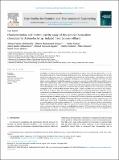| dc.contributor.author | Bakari, Omari | |
| dc.contributor.author | Njau, Karoli | |
| dc.contributor.author | Noubactep, Chicgoua | |
| dc.date.accessioned | 2023-10-06T10:01:56Z | |
| dc.date.available | 2023-10-06T10:01:56Z | |
| dc.date.issued | 2023-12-08 | |
| dc.identifier.uri | https://doi.org/10.1016/j.cscee.2023.100377 | |
| dc.identifier.uri | https://dspace.nm-aist.ac.tz/handle/20.500.12479/2129 | |
| dc.description | This research article was published in Case Studies in Chemical and Environmental Engineering Journal, Volume 8, 2023. | en_US |
| dc.description.abstract | Iron metal (Fe0) materials enhance the performance of anaerobic digestion (AD) reactors to remove pollutants. Most research focused on the materials' mechanisms and effectiveness in enhancing AD. However, there is scant information on the biogas and sludge quality and quantity and the kinetics of generated methane (CH4) of biogas from the Fe0-aided AD of domestic wastewater (DW). The information is essential for AD reactors' management. This study characterizes the sludge and biogas from Fe0-aided AD of DW and predicts the CH4 yield using the Gompertz, Logistic, and Richard models to study the impact of Fe0 materials on the composition and generation of sludge and biogas. Bench-scale reactors containing DW were fed with Fe0 and operated for 53 days in a quiescent condition, at 24 ± 3 OC room temperature, at 7.3 initial pH value. Steel wool and iron scrap were used as Fe0 sources. A parallel experiment without Fe0 was performed as an operational reference. Results indicate that Fe0 significantly enriched most of the nutrients in sludges, produced well-settling sludge (sludge volume index ≤30), and enriched the CH4 of biogas by more than 12%. Furthermore, all the tested models exhibited good fitting (error <10%) in predicting CH4 production. Fe0-aided AD produced a sludge with the potential for application in agricultural land and increased the heating value of the biogas by enriching the CH4. More than 80% of particles generated from Fe0-aided AD of DW can be settled in sedimentation tanks designed at an overflow rate ≤40 m/d. Richard was the best model for predicting methane yield from Fe0-aided AD of DW (error <1.6%). | en_US |
| dc.language.iso | en | en_US |
| dc.publisher | Elsevier | en_US |
| dc.subject | Anaerobic digestion | en_US |
| dc.subject | Biogas | en_US |
| dc.subject | Domestic wastewater | en_US |
| dc.subject | Metallic iron | en_US |
| dc.subject | Nutrients | en_US |
| dc.subject | Sludge | en_US |
| dc.title | Effects of zero-valent iron on sludge and methane production in anaerobic digestion of domestic wastewater | en_US |
| dc.type | Article | en_US |

